|
TennisOne Lessons

Follow-through Facts and Fiction
Doug King
Of all the laments and the urgings that I hear people make to themselves after they miss a shot, probably the most common is the reminder to "follow-through." The irony is that despite how common this exhortation is, it very rarely has any relevance to the cause of the missed shot. To think the follow-through is going to save a shot that is mis-timed, mis-hit, or misplaced is simply a misunderstanding.
The truth is that the fate of the shot has been cast well before the follow-through even takes place. Once the ball leaves the strings (and this happens very, very soon after contact) the movement of the racquet has no influence over the ball. So arguably what we do with the racquet after we hit is relatively inconsequential.
In this article we will look at the real role of the follow-through, what part it plays in helping to develop positive stroking results and what myths are commonly attached to the follow-through. We will look at how we have developed certain perceptions about the follow-through and where these perceptions meet with reality. We will not define the follow-through as specific positions but instead look at the "nature" of the follow-through and create a different sense of what constitutes a "good follow-through."
The "Follow-through" and the "Positional Based Swing Approach"
So how did we come to obsess so much with the follow-through?
To determine this we can look at how we introduce players to the game of tennis. We typically begin by introducing them to the "ideal" stroke pattern consisting of ready position, turn, step, and finish. This is a usually implemented through the repetitive delivery of carefully tossed balls that allow the student to develop a consistent stroke pattern. The object is to ingrain as quickly as possible the feeling of a proficient stroke movement. The concept is patterning through repetition to develop "good habits."
When we teach the stroke pattern we emphasize the start and finish positions - a "Positional Based Approach." These are relatively static positions (especially the finish) so we can observe and manage them, whereas the dynamic flow of movement between these two points is much more difficult to control and diagnose. So right from the beginning the coach and student are focused on these positions of start and finish. The theory is that if you start well and finish well everything else will fall into place. And if it doesn’t, well that will develop with time and practice. Whether or not this is a valid assumption is another discussion but the problem with this approach is that it leads the player and the coach into putting an inflated value on the follow-through position.
The "Necessary but Not Sufficient Condition"
The player begins to see the follow-through as the ending destination of the swing. "Swing through the ball and get to your finish," the coach repeats and so the player is trained to see the end of the stroke as the point that he is swinging to. Soon the player is concentrating more on getting to the follow-through rather than actually hitting the ball.
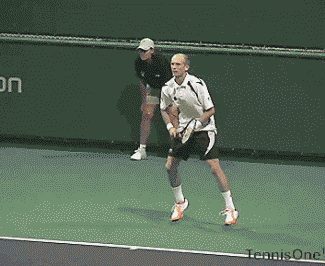 A consideration of the follow-through is how it helps to stabilize the racquet through contact and maintain balance but it carries no guarantee on the contact or the purity of the hit.
A consideration of the follow-through is how it helps to stabilize the racquet through contact and maintain balance but it carries no guarantee on the contact or the purity of the hit. |
The coach can also fall into the danger of putting too much emphasis on the follow-through. He may learn to evaluate the success of a stroke based upon what he sees on the follow-through. "You missed that shot because you didn’t follow-through" is often the comment from the coach heard by the student. Soon the player is led to believe that the follow-through is the root and the panacea of all stroking issues when in reality the follow-through is much more of a secondary "consequence" of the primary event - the contact of the ball. It should not be misconstrued as the fundamental "cause" of the contact of the ball.
In economics there is a term referred to as a "necessary but not sufficient condition." This is where a condition will always exist as a result of an occurrence but the presence of the condition is not enough to guarantee that the occurrence will happen. This is how the follow-through exists within the relationship to the stroke. If you have a good stroke the follow-through must necessarily be good. However a good follow-through alone is not enough to ensure a good stroke. The follow-through is not a purely causal condition for a good stroke.
"Squaring Up" to the Ball and "Coming Off" of the Ball
In my opinion it is critical to understand that the most important and difficult thing to do in tennis is to "square up" to the ball - that is to actually meet the ball solidly. This is when three things occur simultaneously; one is the ball meets the racquet in the sweet spot, two is the racquet face aligns to the target, and three is the body shifts into balance. When this happens we have good contact. A great majority of the mistakes that occur in tennis are due to of our inability to meet the ball properly. When we can accomplish this goal a good follow-through will easily follow. The problem is that it is not only difficult to achieve a consistent solid contact; it is also very difficult to teach it. Consistent "squaring" to the ball requires so many coordinated delicate movements that it almost defies description. It is a very complex orchestration of positive and negative movements that are highly timing and feel sensitive. And since the ball and the conditions of the stroke are constantly changing it is very difficult to define a consistent pattern for this process.
It is also very difficult for the player to analyze all of the subtle movements associated with good contact. It can be overwhelming to breakdown all these movements. We are all familiar with players that anguish over the subtle intricacies of the swing. They can drive themselves crazy trying to analyze these nuances and we typically say they are "over thinking." This may be true but it is very common (and almost logical) to get to this point of "over thinking." Professional players of all sports understand the complexity and the critical nature of learning this skill of "squaring up," whether it is golf, baseball, tennis, or any other similar sport. If you went to a professional baseball game you would see top hitters warming up their strokes on a tee, trying to isolate a subtle position or nuanced move leading to contact. The same is true with golfers and tennis players. This is why pro tennis players often warm up with mini tennis - so that they can get the feeling of "squaring to the ball."
But it is a difficult process and we are not professional players and we may not have all of time in the world to devote to the practice of learning this skill. After all, we are just playing tennis for fun. So we tend to develop an "ignorance is bliss" approach and simply say to ourselves "follow-through" after we miss a shot. It makes it a lot easier than saying "remember to rotate your forearm back and tuck your elbow into you ribcage, push your right hip up and turn your shoulder, and then relax your wrist…" - you get the point.
The "Follow-through Fallacy"
The danger is that we start to "believe" what we say to ourselves. Those admonitions to "follow-through" start to make an impression and soon we are thinking so much about following through that we forget that the real destination of our stroke is the ball and controlling that small space through the contact. We develop a belief that the follow-through can do more than what it can - that it can add power to a stroke (it can’t) or add accuracy to a shot (it can’t) or that it can make a ball hit the center of the racquet (it can’t).
This is what I call the "Follow-through Fallacy." In a sense the follow-through is probably the least consequential part of the stroke. In fact, almost all of the follow-through is either "stroke exhaust" or "recovery." I say "stroke exhaust" because it is essentially a byproduct of the energy that is put into the contacting of the ball. It is the natural result of the effort put into the acceleration of the stroke through contact.
It is also a lot of "recovery," that is it is bringing the racquet back into the body to regain balance after a shot. In this sense a significant portion of the follow-through is actually designed to get you ready for the next shot rather than having a significant impact on the shot that you just hit, as we are led to believe.
Follow-through Positives
Still the follow-through remains an important part of the stroke. If approached correctly, the follow-through can have very positive effects on the stroke.
In my opinion a good follow-through will do a couple of things. One is that it will allow one to keep better focus in the contact zone. It will help to keep the head down and give a better sense of the oncoming ball going into contact and a better sense of the target coming out of contact. A follow-through should not draw attention to some point away from contact but instead should encourage focus on the ball through contact. It should then reveal a momentary (or longer) sense of the target just after contact. Most people are so focused on "following through over their shoulder" or wherever, that they are totally distracted from the ball and the target. In this sense the follow-through just pulls them out of the shot causing them to take their eye off of the ball and mis-hit the ball.
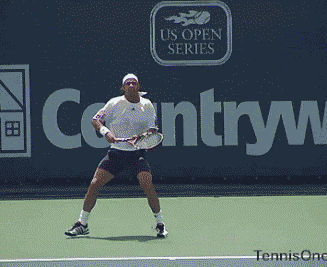 The fundamental aspect of the follow-through is helping to achieve the proper swing tempo.
The fundamental aspect of the follow-through is helping to achieve the proper swing tempo. |
In reality, many of our traditional follow-through techniques are designed to help us stay in the contact zone and keep us from following through too much or too quickly. For example, when we tell students to think of hitting through a series of balls the object (or result) is to keep the racquet in proper alignment and to prevent it from whipping through the contact zone. To hit through a series of balls you must let the wrist fold back a bit through the contact zone which will reduce momentum at the tip of the racquet head, thereby increasing stability and alignment to the target.
The same case can be said for the technique of catching the racquet in the non-hitting hand after contact. This prevents the racquet from swinging too forcefully on the follow through and encourages the racquet to stabilize through the contact zone. Even the "windshield wiper" forehand follow-through is designed to stabilize the racquet to the target and to minimize racquet head whip although it is also designed to encourage more spin (more on that later).
These techniques of following through are actually important not in what they produce in terms of follow-through but more in what they prevent. Suggestions of "catching the racquet" or "hitting through a series of balls" are counter measures to keep us from following through too quickly or too much - they are in a certain sense "anti-follow-through" follow-throughs!
Aside from helping to better control the racquet in the contact zone, a good follow-through should promote proper tempo in the stroke. This may be the fundamental purpose of the follow-through, which is to get the player to achieve the proper swing tempo. Many players have a tendency to whip or slap the racquet into the ball. Forward swinging at the ball is one of the most common errors in the game. Tennis after all is a "lifting and turning game" and not a "swinging and hitting game" (more on that another time) so it is critical to eliminate most of the forward swinging of the arm and racquet just before contact to achieve proper swing tempo. If you come into the ball at the correct swing speed (slower than what most people think) there will be an acceleration required to get adequate swing speed that will automatically result in a follow-through. In a way when we say "follow-through" what we are actually telling people to do is to "slow down" as you approach the ball or "don’t swing so fast!"
Once again the follow-through does not insure proper swing tempo but it will naturally be a condition that exists if proper tempo does occur.
The "Mini Follow-through" Approach
Even though a follow-through is an indication of good swing tempo, you don't necessarily need much of a follow-through on all shots. In fact it is often a good practice to try and minimize your follow-through.
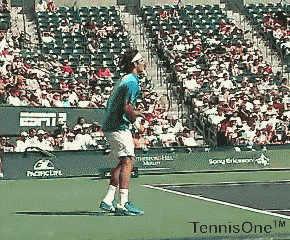 When pressed, Federer can square to the ball with a minimal follow through and still get pace - a sign of great hands and timing.
When pressed, Federer can square to the ball with a minimal follow through and still get pace - a sign of great hands and timing. |
Most people tend to either whip through their shots or push through their shots. Both flaws will lead to excessive follow-throughs. The whip will produce an excessively wristy follow-through and the push will produce an exaggerated body twist – often throwing the body out of balance. While most people are dazzled by the vigorous follow-throughs of the pros what is even more impressive is how well the pros can hit the ball with practically no follow-through. Following through excessively on many shots is an indication of mis-timing (being hurried) or being off balance, or lacking good hands in the stroke.
If you watch a good return of serve or a good passing shot replayed on television you will often see a totally abbreviated follow-through. That is not easy to do and it is an indication of perfect timing, racquet and body control. Most players are flailing in these situations - over swinging and over following though.
From this perspective we can look at the volley as a case in which the follow-through is best understood and explained. We are instructed to "not swing" and to use a very minimal stroke. In fact there is a follow-through on the volley but it is kept to a minimum and is designed not to detract from the primary objective of meeting the ball and directing it accurately to the target.
By practicing a shorter follow-through on many shots, you can observe what is happening through the contact more clearly, and develop more control of this phase of the stroke. Instead of telling yourself to "hit through the ball and finish," try telling yourself to "meet the ball and go to the target." Remember that most of the follow-through is coming off of the ball and/or stroke recovery so it is not essential to generating power. By placing too much focus on the end of the stroke you may distract attention from the critical aspects of contact.
Follow-through and the Serve
An indication that the follow-through is not the source of power that many many are led to believe, is the fact that we see so many abbreviated follow-throughs in the pro game today. Many players will follow-through low and very close to the body rather than reaching out or over the shoulder. Two handed strokes force more abbreviated follow-throughs, and they accomplish not with a loss in power but with an increase in power.
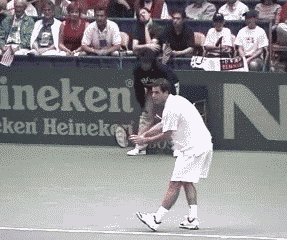 The Sampras serve made us reconsider the role of the follow-through on the serve.
The Sampras serve made us reconsider the role of the follow-through on the serve. |
This phenomena applies not only to groundstrokes but to all strokes. Take the case of the Pete Sampras service action. Sampras, in my opinion, had the most consistent, powerful, accurate serve ever and he performed this with a remarkably abbreviated follow-through. In fact I believe the Sampras serve revolutionized to some degree our thinking about the serve and the follow-through. With his signature high elbow in the air finish, he made us abandon the "follow-through down and across the body" technique that had been a benchmark of a proper service motion for so long. Eventually we learned to recognize this move of "down and across the body" for what it actually was - simply a recovery move that regains balance and brings the server back into ready position. The traditional follow-through had very little to do with the actual powering or directing of the ball and by emphasizing this move we may have simply been diverting attention away from the main event - the contact zone. Now players realize that it is exactly the old follow-through position (down and across to the left) that they are trying to avoid as they drive through contact in an up and away to the right extension. This is another example of an "anti-follow-through" follow-through designed to keep you in the contact zone more effectively.
The Follow-through and Spin
The follow-through can add control to your stroke and this is because it can actually take power off of your shot. Since following through is primarily coming off of the ball it actually can reduce power and by reducing power you can increase consistency to your shots.
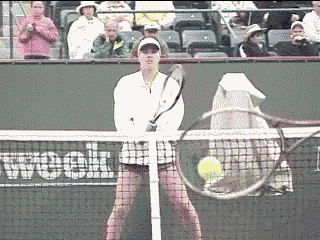 The follow-through on the volley is kept to a minimum and is designed not to detract from the primary objective of meeting the ball. A good goal of follow-throughs
The follow-through on the volley is kept to a minimum and is designed not to detract from the primary objective of meeting the ball. A good goal of follow-throughs
on all strokes. |
Coming off of the ball is also a necessary part of adding spin to the shot. Spin can almost be defined as a process of coming off of the ball (in a rolling, turn of the ball). Spin is a critical part of gaining control over the shot and so the follow-through is an important part of this process. The type of spin and the amount of spin will be reflected in the follow-through. Some would say that the follow-through determines the spin, or you could also say that the follow-through is an indication of the type and the amount of spin that was applied through contact. Certainly by addressing a particular approach to the ball and then a certain follow-through spin can be learned. But again the follow-through should be recognized not as the cause of the spin or the object of the stroke but simply as a helpful tool to learn the spin.
Emphasis should be kept on the act of spinning the ball as opposed to simply "following through" a certain way. Remember that before you come off of the ball you need to engage on to the ball in order to get effective pace and penetration with your strokes.
The Follow-through and the Body
Another thing that is important to realize is that much of the follow-through that is significant is occurring in the body and is not just a matter of racquet movement. In fact the racquet should be kept relatively passive in the wrist through contact and during the follow-through while it is in the body where many of the important movements are taking place. These more subtle shifts are less obvious but are often the critical parts of a good stroke.
Many times we suggest a certain racquet position on the follow-through to help get the body to make the right move. We may say extend the racquet to the target or finish with the racquet over the shoulder because this swinging action of the racquet may encourage the body to shift properly. But we may be putting the cart before the horse. Simply swinging the racquet to a certain position may encourage the body to shift but it does not necessarily force this shift in the body.
Always be sure to pay attention to the body shift as part of the follow-through. This can be a turn of the body, a lift of the shoulder, the straightening of the back, a step, a push on the ball of the foot, a contraction here, an extension there - but it usually involves a lot more than simply ending up with your racquet in a certain position. By emphasizing the racquet movement as the significant part of the follow-through we may be pulling the racquet out of the hit before the body has a chance to make any significant contribution. I prefer to think of trying to get the body to make a certain action while the ball and the racquet are together in the contact zone rather than simply trying to move the racquet out of the contact zone and to a somewhat arbitrary "follow-through position".
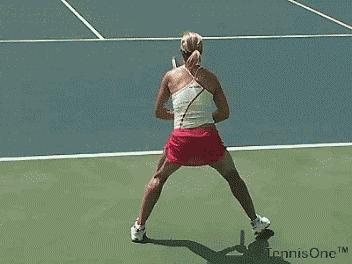 This over the right shoulder or reverse finish is the result of the swing pattern and spin Dementieva used on the stroke but not the cause of it.
This over the right shoulder or reverse finish is the result of the swing pattern and spin Dementieva used on the stroke but not the cause of it. |
Summation
When we watch the pros we are often captivated by the ferocity and variety of their follow-throughs. We see abrupt follow-throughs that break off with a sudden twist a la Federer and we see huge reverse finishes over the head like Sharapova and Nadal and everything in between. Even "classic" players like Sampras and Davenport often had "radical" follow-throughs mixed in with more traditional finishes.
Because the follow-through is so apparent and because we are brought up on a steady diet of commands to "follow-through," we often put too much emphasis on the follow-through. I agree that the follow-through will affect how we go through contact but it is exactly this impact that is most significant about the follow-through; that is, how it effects our contacting of the ball. I totally agree with the efficacy of stressing the follow-through in order to achieve certain results
The follow–through is a double edged sword. If you overemphasize the follow-through you can easily end up compromising the contact of the ball and end up with frequent mis-hits. On the other hand, without a proper follow through the swing will often lack proper spin and tempo and the result can be solid contact but shots that will hit the back fence. The trick is to learn how to integrate the follow-through into the stroke pattern to produce positive results (controlled power through tempo and spin) rather than negative results (off center hits by pulling our of the shot).
The follow-through is not the "end " in itself. It is merely an indication, a consequence, a condition, or a helpful tool. It is not the main event and does not directly ensure or cause the result of the main event. It can give us clues and suggestions about the stroke but it does not reveal the pithy details of timing, grip, touch, angles, and fluidity. It is important in as much as what it stops us from doing (pulling out of the shot) as it is in what it encourages us to do (accelerate and turn the ball).
In reality there is no single follow-through nor a "perfect follow-through." It is situational depending upon the specific shot being played and should therefore reflect this. During your training it is fine to develop a consistent follow-through as a "base stroke pattern," but don’t get stuck thinking that you must follow-through a certain way in order to hit a good shot or that the follow-through somehow will magically cure a stroking error.
Try to develop a follow-through that is comfortable; one that allows you to stay on balance through the stroke, and will allow you to both see the ball going into contact and sense the target coming out of contact. Learn to meet the ball squarely before you end up adding excessive spin - and never let the attempts to follow-through a certain way compromise your ability to "square up to the ball." Where the racquet ends up will vary depending on what you were trying to do with the ball and the position of the ball when you were striking it. So give yourself a little room to vary your follow-throughs. Pay more attention to the ball and the target and don’t sweat the follow-through so much and you will be finishing more like the pros.
Your comments are welcome. Let us know what you think about Doug King's article by emailing us here at TennisOne.

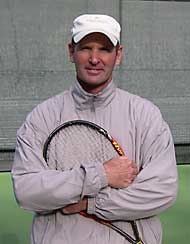  Doug King studied with legendary tennis coach Tom Stow and was a
former California State Men's Singles Champion
and the former number one men's player of Northern California. Doug King studied with legendary tennis coach Tom Stow and was a
former California State Men's Singles Champion
and the former number one men's player of Northern California.
Doug is one of the country's foremost tennis teaching innovators. Founder of Acceleration Tennis, a revolutionary teaching system, King is leading the way in reinterpreting the traditional tennis model.
Doug King is currently Director of Tennis at Meadowood Napa Valley ( www.meadowood.com ), a Relaix Chateau Resort in St. Helena , CA .
For more information on Acceleration Tennis please email Doug King at dking@meadowood.com.
|







 Doug King studied with legendary tennis coach Tom Stow and was a
former California State Men's Singles Champion
and the former number one men's player of Northern California.
Doug King studied with legendary tennis coach Tom Stow and was a
former California State Men's Singles Champion
and the former number one men's player of Northern California.